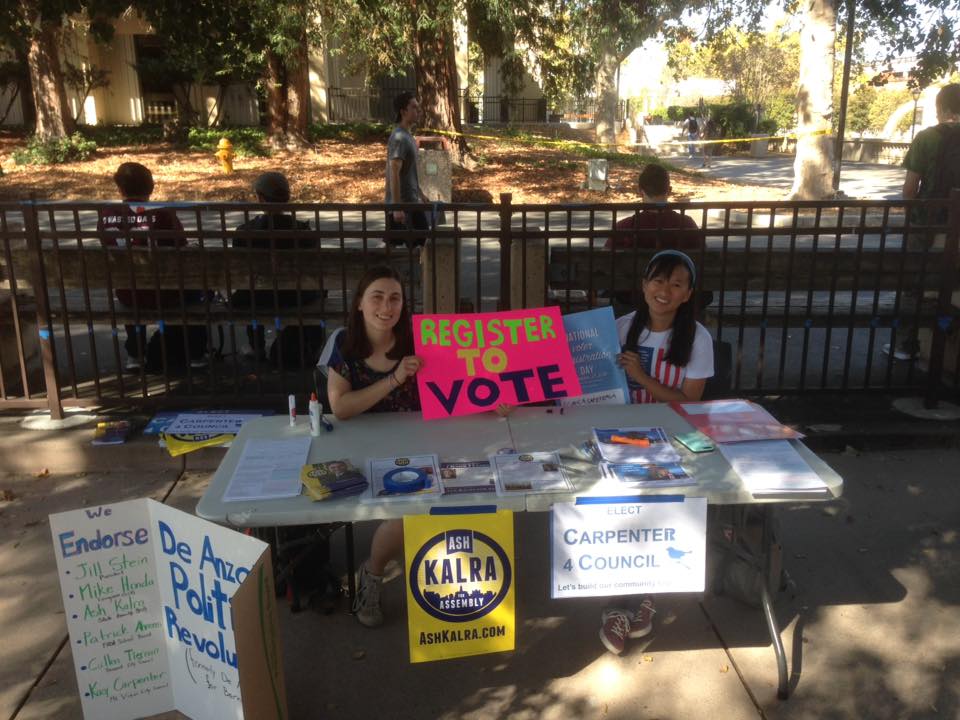Student club continues Senator Sanders’ movement
November 7, 2016

and Megan Fernandez, 21, history major encourage students
to get politically active in the main quad on Thursday, Sept.
29.
With the rise and fall of Vermont Sen. Bernie Sander’s presidential campaign in the past year, the De Anza for Bernie Club found its goals challenged and reinvented. The club plunged into political activism in Fall 2015, inspired by Sanders’s ideologies. Students participated in near daily phone banking, door-to door endorsement, information distribution and debate watch parties.
The political science department at De Anza fostered the organization’s growth by requiring civic duty hours, or volunteering with a political organization. The club found 30 to 80 students per quarter coming in to help build the campaign. At the height of De Anza’s political energy, celebrity surrogates from the campaign such as Kendrick Sampson from “How to Get Away with Murder” and Max Carver from “Desperate Housewives” held events to encourage voter registration on campus.
The local District 17 organizer, Eliana Jimenez, would often use De Anza as a headquarters for organizing. “Push for Progress,” a self described volunteer grassroots organization, would join the organizing efforts on campus. De Anza for Bernie offered rooms, projectors and other facilities in aiding the campaigning.
Eddie Cisneros, president of the club, said members worked really hard for a year until the California primary came. “It was quite the disappointment, to say the least,” Cisneros said. “But like Bernie said, ‘It’s not me, it’s us,’ and that win or lose we need to push this political revolution.”
The transitional period found many clubs shifting their focuses. For example, UCLA’s Bruins for Bernie changed their name to Young Progressives Demanding Action. President of the UC Irvine’s BernEaters, William Léonard, said that the group kept their name because whether or not Sanders won does not change where they came from or what they stand for.
“Just because we founded the club in light of Bernie’s revolution does not mean we stop after Bernie is elected or loses,” Léonard said. “We still support local candidates with progressive values like ourselves.”
De Anza for Bernie initially wanted to change its name to “De Anza’s Our Revolution,” replicating Sanders’s movement, “Our Revolution”. Cisneros said some people found the name to be problematic due to Sanders’s endorsements of presidential candidate Hillary Clinton, and wanted to stay separate.
“We kind of wanted to go back to the original message that Bernie Sanders was saying,” Cisneros said. “We need this political revolution to happen whether he wins or not and we’re also there for the people who don’t support his decision in endorsing Clinton.”
The club settled on “De Anza’s Political Revolution.” Cisnero said the club is trying to figure out how to engage students because the upcoming election has such high stakes.
“It’s hard to organize because there was a divide after Bernie left the race and endorsed Clinton. I’ve seen friendships end, many times, over this,” Cisneros said.
The club would continue pushing for the values Bernie endorsed, such as education, healthcare, voter rights and the environment, he said. The club now focuses on endorsing candidates from a national to local level. Some examples are Ash Kalra for state assembly, Patrick Ahrens for the Foothill-De Anza school board, as well as city council members Cullen Tiernan and Ken Carpenter.
“I think even just getting some students involved in one local campaign is already a huge thing to bring,” Aleks Niewczas, vice president, said. Niewczas said the club aimed to help people figure out how to participate politically.
“It’s your local representatives that are supposed to be advocating for your needs to Congress,” Cisneros said. “We want to give the opportunity, and the experience, for students to be able to find what they’re passionate about and give them the tools to organize it themselves.”
Cisneros said he wanted to empower community members, including international students, with the knowledge that they have power to create change in the political system. Cisneros said the club infrastructure is nearly finished being built and ready to start being tested.
“Things may work, they may not, and that is what we’re going to have to learn,” Cisneros said. “We’re going to continue to keep trying, because this is so important not only for our future, but our children’s futures and everyone around the world.”

